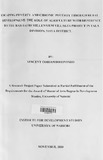| dc.description.abstract | This study explored the role of Millennium Villages Project intervention in agriculture as an
escape route out of poverty and chronic poverty in Siaya district. The ultimate goal of rural
development is improved livelihoods and poverty reduction. Agriculture is an important and
integral part of the livelihood strategies for many rural poor. Subsistence agriculture continues
to be a major determinant of rural household welfare in rural Kenya.
The study findings established the multidimensionality of rural poverty and that agriculture still
harbours many people in a poverty trap. In spite of MVP interventions in agriculture poverty and
hunger still threatens human survival and livelihoods. An effective response therefore requires a
better understanding of what it means to be chronically poor and better analysis of the
characteristics and underlying social processes that result in sustained poverty. Furthermore,
agricultural growth and poverty reduction strategies need to take into account the constraints
faced by poor and chronically poor smallholders with regard to accessing inputs, microfinance,
education and livelihoods diversification in the rural areas. Overall, the study contends that
smallholder agriculture faces large uncertainties as a result of rapid population growth,
declining farm sizes, falling soil fertility, environmental degradation and threat of climate
change.
The study findings have a number of important implications for the design of interventions,
strategies, program mess, and policies for reducing poverty and supporting smallholder
agricultural growth in the rural areas. It calls for actions that can fundamentally transform
access to the most basic needs of the poorest and rural areas such as food, health and education.
In addition, it calls for the need to provide the poor with support in subsidy, extension and
research, access to credit, education and training. Lastly, the papers' conclusion is that the
ability of the poor to engage in productive activities in a sustainable manner and the prospects of
'intervention development' in the rural areas depend heavily on the wider socio-economic,
political and institutional environment within and beyond the rural domain. Therefore, there is
need to acknowledge the diversity of pathways out of poverty as agriculture alone cannot relieve
rural poverty, though self-evidently is part of the answer. | en |

